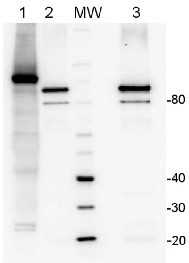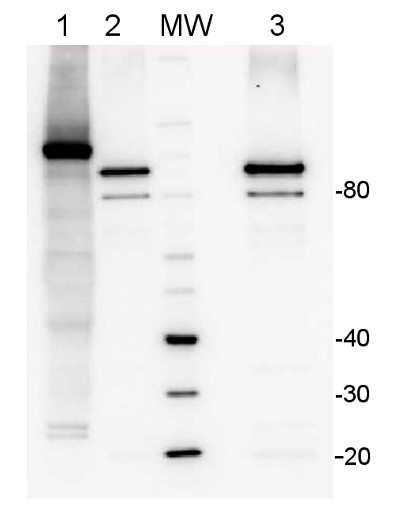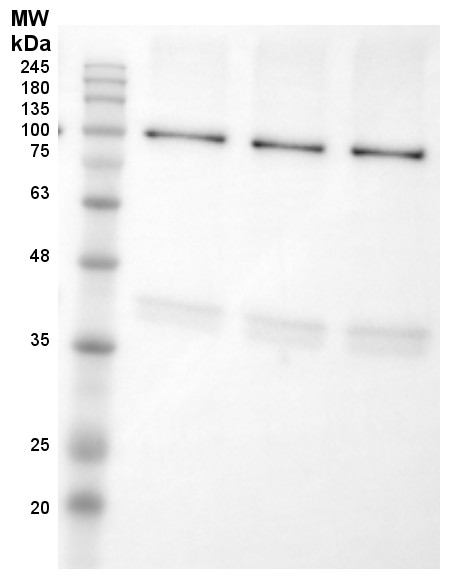1

Anti-LOX | Lipoxygenase (Affinity purified)
AS06 128A | Clonality: Polyclonal | Host: Rabbit | Reactivity: A.thaliana, G. max, S. tuberosum
- Product Info
-
Immunogen: native lipoxygenase, type I-B, purified from Glycine max (Sigma, product number L7395) UniProt: P08170
Host: Rabbit Clonality: Polyclonal Purity: Immunogen affinity purified serum in PBS pH 7.4. Format: Lyophilized Quantity: 50 µg Reconstitution: For reconstitution of lyophilized unit please add 50 µl of sterile water Storage: Store lyophilized/reconstituted at -20°C; once reconstituted make aliquots to avoid repeated freeze-thaw cycles. Please remember to spin the tubes briefly prior to opening them to avoid any losses that might occur from material adhering to the cap or sides of the tube. Tested applications: Western blot (WB) Recommended dilution: 1 : 5000 (WB) Expected | apparent MW: 94 | 94-100 kDa (depending upon the species)
- Reactivity
-
Confirmed reactivity: Arabidopsis thaliana, Glycine max, Solanum tuberosum
Predicted reactivity: Cucumis sativus, Lathyrus undulatus, Malus x domestica
Species of your interest not listed? Contact usNot reactive in: No confirmed exceptions from predicted reactivity are currently known - Application Examples
-
Application example 
10 µg of total protein from Arabidopsis thaliana (1), native LOX protein from Glycine max (2,3) total protein from all the samples were extracted with Protein Extraction Buffer PEB (AS08 300). Samples were diluted with 1X sample buffer (NuPAGE LDS sample buffer (Invitrogen) supplemented with 50 mM DTT and heat at 70°C for 5 min and keep on ice before loading. Protein samples were separated on NuPAGE 4-12% Tris-Bis gel (Invitrogen) LDS-PAGE and blotted for 1h to 1.5h on PVDF using tank transfer. Blots were blocked immediately following transfer in 2% blocking reagent or 5% non-fat milk dissolved in 20 mM Tris, 137 mM sodium chloride pH 7.6 with 0.1% (v/v) Tween-20 (TBS-T) for 1h at room temperature with agitation. Blots were incubated in the primary antibody at a dilution of 1: 5 000 (in blocking reagent) for 1h at room temperature with agitation. The antibody solution was decanted and the blot was rinsed briefly twice, and then washed 1x15 min and 3x5 min with TBS-T at room temperature with agitation. Blots were incubated in secondary antibody (anti-rabbit IgG horse radish peroxidase conjugated, recommended secondary antibody AS09 602) diluted to 1:25 000 in blocking reagent for 1h at room temperature with agitation. The blots were washed as above. The blot was developed for 5 min with chemiluminescent detection reagent according the manufacturers instructions. Images of the blots were obtained using a CCD imager (FluorSMax, Bio-Rad) and Quantity One software (Bio-Rad).

Proteins were extracted from tuber flesh of Solanum tuberosum cv. Russet Burbank with 0.1 M Tris HCl (pH=8.0), 5% sucrose (m/v), 2% (m/v) SDS, protease inhibitors (PMSF 1mM). Samples were heated 95°C 5 min, and 10 μg of total protein was resolved in 12% SDS PAGE and blotted to PVDF membrane for 1h-1.5h using tank transfer. Blots were blocked with a skimmed milk 4% (m/v) in T-TBS (1.5h) at RT with agitation. Primary antibodies (AS06 128A) were applied overnight +4°C in dilution 1:5000 with agitation. After washing with T-TBS 2 times, membrane was incubated with secondary antibodies (Goat Anti-Rabbit HRP conjugated) 1:10 000 for 1 hour at RT. Blot was washed as above and developed with chemiluminescence detection reagent, for 5 – 10 minutes. Exposure time – 7.000 seconds.
Courtesy of Msc. Iauhenia Isayenka, Laboratory of Nathalie Beaudoin, University of Sherbrooke, Canada
- Background
-
Background: Lipoxygenases (LOXs; EC 1.13.11.12, synonym: lipoxydases) are a family of enzymes that catalyze oxygenation of polyunsaturated fatty acids (PUFAs) into lipidhydroperoxides (LOOHs) involved in responses to stresses. LOXs has been found to play a role in plant growth and development, senescence as well as can be activated in response to environamental stress (drought, heavy metals).Synonymes: linoleate, oxygen oxidoreductase.
- Protocols
-
Agrisera Western Blot protocol and video tutorials
Protocols to work with plant and algal protein extracts - Reviews:
-
This product doesn't have any reviews.



